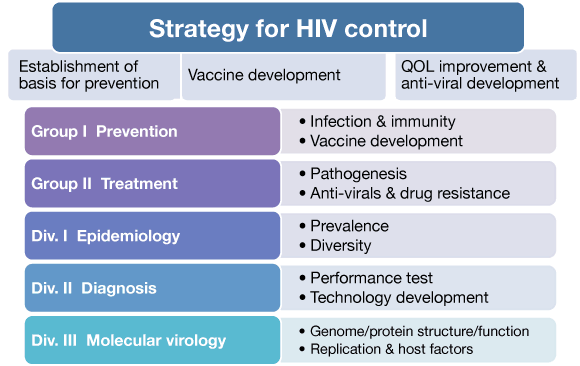Infectious Deseases
Basic Research
Surveillance
Information
- Details

The AIDS Research Center (ARC) was established in April, 1988, to reinforce the research activities on HIV/AIDS. This Center, consisting of two research groups and three divisions, is working on HIV- and other retroviruses-related diseases. The principal objective of ARC is to contribute to the control of HIV infection. Current activities of ARC include surveillance and epidemiological analyses on HIV infection in Asia and Africa as well as Japan, ensuring sensitive and accurate systems for diagnosis of HIV and HTLV infection, monitoring domestic drug-resistant HIV variants, research on replication mechanisms of HIV and related viruses, establishment of animal models, and analyses of immune responses and pathogenesis in HIV and related virus infection. Furthermore, projects toward development of vaccines and intervention strategy for viral control are in progress. ARC is making collaboration with multiple research laboratories in foreign countries as well as Japan. At the request of JICA, ARC annually holds a training course, “Strengthening laboratory techniques and surveillance system for global control of HIV and related infectious diseases”, for researchers and laboratory workers in African and Asian countries.
Research Group I
(Group for Vaccine Research & Development)
This group aims at elucidation of the immune mechanism for the control of HIV and related virus infection using animal models and clinical samples, and development of effective vaccines. An international collaborative project is ongoing toward a clinical trial of a vaccine using Sendai virus vectors.
Research Group II
(Group for Therapeutic Research & Clinical Science)
This group aims at improvement of QOL of HIV-infected people, elucidation of the pathogenesis, and development of novel therapies.
Division I
(Division for Epidemiology)
The main activity of this division is to analyze domestic and international prevalence of HIV and other retrovirus infection. This division is also working on epidemiological analysis and viral genome evolution, including surveillance of drug-resistant variants.
Division II
(Division for Diagnosis)
This division is involved not only in official reference activity concerning laboratory diagnosis of infection but also in establishment of accurate diagnosis system able to detect highly-diversified viruses in HIV and other retrovirus infection.
Division III
(Division for Molecular Virology)
This division is performing molecular biological, virological, and pathological analyses to determine viral genome/protein structure and function and elucidate the mechanism of viral replication with identification of related host factors in HIV and other retrovirus infection.